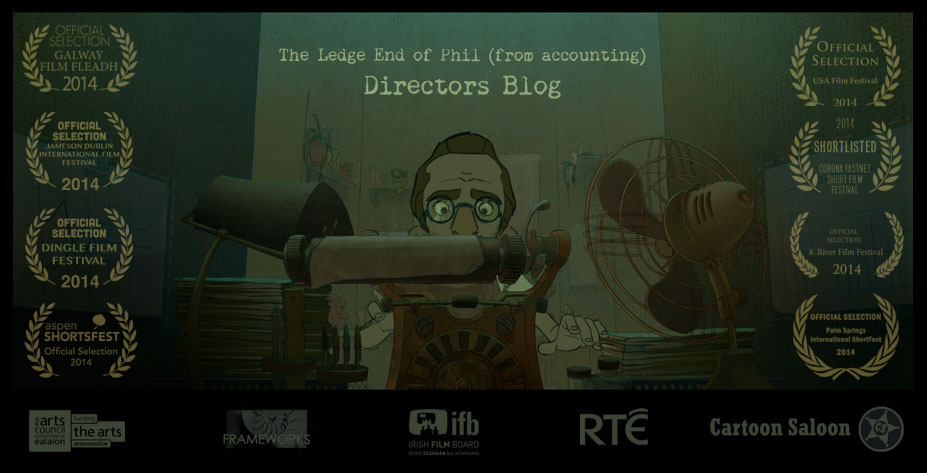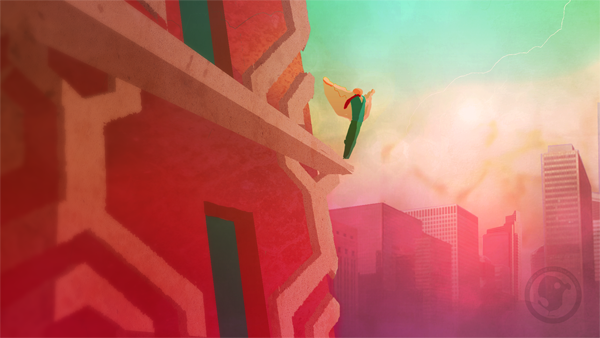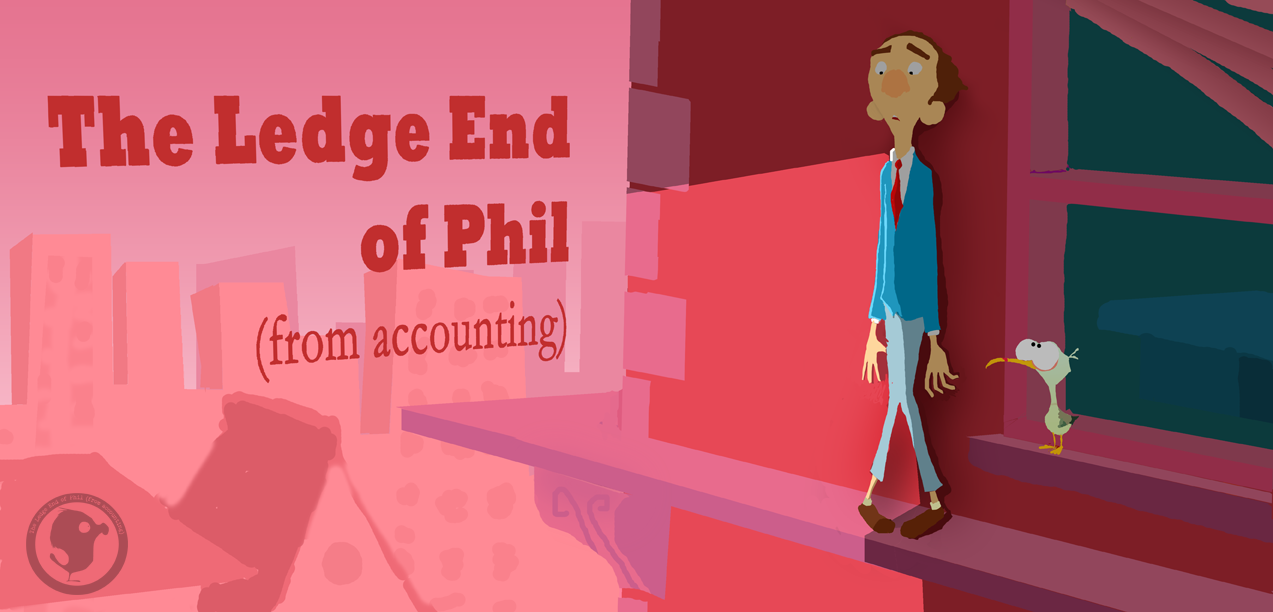I realise alot of people reading this
won't have actually seen the film yet, so for now what you need to
know is The Ledge End of Phil (from accounting) is the story of Phil,
a meek office worker who after chasing a page onto the ledge of his
building finds himself trapped outside. Phil quickly realises his only hope of getting back
inside is a seagull who has conversely been trapped inside. The gull
however is too busy picking apart Phils life i.e. the items on his
desk. But as night falls Phil begins to take notice of the world beyond his office.
Up until now my focus had been on writing funny scenario's for Phil as he tries to get back
inside. But now there was a chance i may actually get the film made I started stripping down the story to find what it was beneath
the surface I was connecting to. Not just that, i realised i wanted to make
a film i'd like to see. This seems obvious, but the shorts i'd made
in the past where film's i wanted to make, but not necessarily watch.
So i wrote some guidelines on what i did and didn't want to do
No dialogue. Phil never had a
voice in any version of the story. He never needed one, it was more
about his actions and reactions
No narration. I find narration
is used too often as a crutch for poor storytelling. There are of
course great examples (
Gerald McBoing Boing is still a masterpiece) but
Dr Seuss i am not.
A film that is self contained.
That all elements of the film would be organic to the story. No
references to popular culture or other films. (ok i got this one from
pixar, but i agree with it) and that it would be a world existing within it's
own time and place.
Character evolution: I realised
i was writing the story to show Phil grow as a person, i wanted to
push him outside his comfort zone and force him to confront himself.
The story to be about five to six
minutes in length. I like to have boundaries when i write, it's
nice knowing i have 5 pages to fit everything into, it forces me to
cut things out. Which is a lot harder than putting more in.
As the adage goes writing is rewriting.
I went through at least twenty drafts of the script boiling down the
ideas before we came to the pitch version. Along the way there were
lots of variation on the characters, how cartoony the animation would
be, who the emotional focus was on from scene to scene.
At
points there was an oblivious janitor character. Stylised animated
dream sequences showing phil's inner monologue. The seagull going on
a wild ride through the office on a fire extinguisher powered office
chair. Two other seagulls who sat on the ledge above Phil watching
his ridiculous scenario unfold who in subtitled french conversed on
the futility of man's endeavors, and then were crushed by a rock.
I even at one point had the idea for a woolen stop motion puppet
playing the part of phil's ulcer... These were all cut because they
were funny but none made the story stronger.
Even though it's Phil's story I at one
point rewrote the entire script from the seagulls point of view, it
wasn't a bad idea, he's a fun character to follow, but in a strange
way it dampened the seagulls character and left us feeling a
detatchment to phil.
The page you see Phil follow out onto
the ledge in the trailer caused rewrite after rewrite because the film
originally began like this
In the script there was never an
opening shot of Phil inside the office (it came later in
storyboarding). This being the case we needed to understand why Phil
would risk his life for a sheet of paper. What the page represented
to him. One of many variations on the page was a version where
a girl he like's in his office gives him her phone number on the
piece of paper with a lipstick kiss, she leaves and the page ends up
getting blown out of the window, later when Phil's trapped out on the
ledge it became about him trying to get her attention as she waits on
the street corner for their date looking at her watch etc. When
Disney's Paperman came out we were about half way through production,
really glad we didn't go down that route!
The
seagulls awareness/sentience were also a big talking point at the beginning. The
gull was kind of the fly in the ointment for phil, his alter ego,
completely free and constantly messing up phil's opportunities to get
back inside. But how aware was the seagull of phil's situation? in
some scene's he seemed to be purposely helping him in others
hindering him. The question became if the gull is sentient why is he
choosing not to help phil? This being the case he seemed a little
malicious which didn't make sense for his happy go lucky character.
Nora Twomey gave me a great note on this which was “Make a logline
for your film and stick to it. If you find yourself writing about
sentient seagulls with a vendetta against office workers ask yourself
what it has to do with your logline.”
Also
in the early drafts Phil was much more daring, he would run wildly
around the building swinging around corners almost falling off.
Though they would have been great fun to animate and watch they
confused Phil's growth and caused a more serious problem, if the
animation can be this wacky how do we know if Phil fell off the
building he couldn't just get up and dust himself off ala wile e
coyote? Your world needs rules and it need's them early. In animation
we are world creators. We control gravity and wind, so if a character
can get hurt we need to show that through the characters reactions to
physical events. There's a great scene in the Iron Giant where
Hogarth terrified runs straight into a tree branch. It's set-up so
well that the whole audience really feels the hit with him, and when
we see Hogarth again there's no cartoon stars twirling round his
head, he lies on the ground with his nose bleeding. That's the
physicality of this world, if he can bleed then he can die.
IRON GIANT REF from
The Ledge End of Phil on
Vimeo.
password: PHIL_BLOG_IG
Each
one of these ideas and a dozen others were crucial to the final story
because of the questions they brought up, forcing me to get a clearer
image in my mind of the story i wanted to tell. In
the end it becomes not about adding things but about taking them
away. To quote Mamet “Take
everything out of a story til you get to the point where if you took
out one more thing it wouldn't make sense.”
After
awhile though i realised i was committing the cardinal sin of
screenwriting, i was writing and rewriting the 1st
and 2nd
act, over and over again... there was never an ending. It would come
to a point where Phil had realised the error of his ways but then i
would just try to make the realisation stronger or the pacing
tighter, anything was easier then actually finishing it. I'd love to
say i wrote 20 versions of the ending too, but in reality one night
as i was drifting off to sleep it came to me all at once, i
thumbnailed the 3rd
act out on a scrap of paper beside the bed and it stayed pretty much unchanged all the way into the finished film. Every element in the
script should be scrutinized but when it feels right it feel's right.
In part 2 i'll be talking about musical influences on the script, my trying to address the problems in the story rather than just talking around them, writing a script not a shotlist , and where the name came from
see you then!













